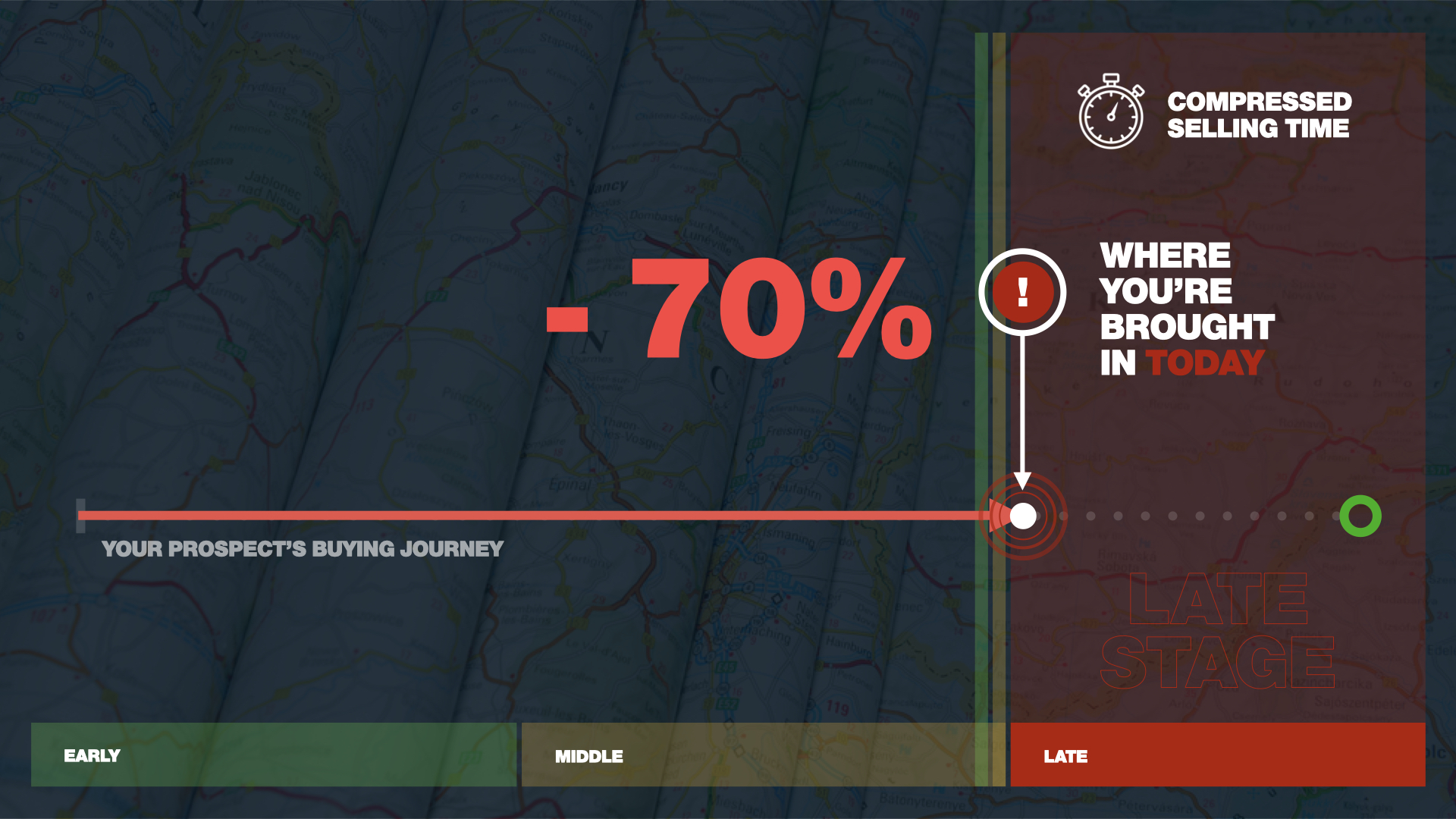Does Our Sales Team Have What it Takes to Win?
Do you want to compete?
Do you reject mediocrity?
Do you commit to finding higher ground?
Hopefully, you answered “Yes”, but you’re still facing one big problem. Your sales team is unprepared and ill-equipped to compete in today’s accelerated age. Unless you do something about it right now, they will stay mediocre and you will never get to higher ground. You’ll become commoditized through consensus decision-makingConsensus Decision-Making Decision making teams average nearly seven people in size. Gaining agreement among seven is challenging, especially when each person has their own priorities. The net result is often indecision or selecting a solution that’s much smaller than what should be purchased to meet the organization’s needs. and compressed selling timeCompressed Selling Time Technology has enabled people to glean more education and insights without the assistance or guidance of salespeople. A 2020 Gartner study demonstrated that 83% of the prospect’s buying journey is completed before the salesperson is invited in. Less selling time prohibits effective investigation of need and trust building, putting all sellers at a disadvantage and making “selling” all about responding to requests, reacting, and order taking., joining in the race to the bottomRace To The Bottom This happens in the procurement sale phase where there’s little to no vendor differentiation in the prospect’s brain. Price becomes the deciding factor, and vendors many times get pitted against each other to win via the lowest possible price. Organizations may hope that later this pricing position can be reclaimed (after the initial sale is made, in future sales), but this rarely happens.. Here’s why.
The Game Has Changed
The ground rules for B2B selling have fundamentally changed. The prospect is completing most of the buying journey without you. They hold off until the last minute, then they bring you and a few other firms that act and sound just like you in for a conversation about fulfillment and price.
This new reality isn’t really new. The COVID-19 pandemic and economic uncertainty have accelerated the impending issues that were, until now, lurking in the background for most B2B firms. For the last 10 years, the expanding markets have allowed you to keep making money without trying that hard. Now, the pressure is on to compete and there are too many good firms chasing too few deals.
In addition to the existing threatsThreats What the primitive brain will act on. Whether real or perceived, the brain prioritizes acting on threats above and beyond any other action. This hurts sellers who are unable to connect the real impact of their product/service to a prospect’s threats. of compressed selling time, consensus decision-making, and commoditizationCommoditization Absence of any perceived value, making it so that price becomes the only determining factor. Whether there is real differentiation or not, if the prospect’s brain cannot or will not distinguish this differentiation, it doesn’t matter., you’re now selling in a virtual environment. Your chances of getting 8-10 decision-makers in a room went out the window when working from home became the norm. But, a salesperson using technology can outperform someone who is selling in person all day, every day. So why would any good salesperson want to go back?
Sales teams today need to be able to hunt down new opportunities to grow. They need to get in earlier and connect with prospects’ priorities. They can’t depend on the market or living off of relationships and deals that were closed years ago. Salespeople are only valuable in this environment if they’re able to get in earlier and meet with higher-level decision-makers. The willingness to sell has to be stronger than ever because sales is harder than ever.

Today, your prospect completes up to 70% of their buying journey before they even reach out to you. This leaves you with less time to make an impact, very little influence on the decision and ultimately, in a race to the bottom because you’ve been commoditized along with your competition.
Here’s What Competitive Teams Are Doing Right Now
Teams that are choosing to compete right now are assessing the talent they have to uncover who has the drive, desire, and ability to sell the way today’s buying teams buy. With these insights, leadership can determine how much more your team can produce and know the true health of your pipeline – and how much more revenue your team is capable of creating.
Like a sports team reviewing game film, high-performance business development teams use every interaction as an opportunity for improvement and train toward real-world scenarios. They’re using objective data to understand and make better decisions on staffing. They’re arming their salespeople with pitches and messaging that connects to their prospects’ real priorities. They’re asking the hard questions that help break through mediocrity and get to higher ground.
Today’s winning teams …
Build a team of high-potential people that want to win.
Use insights to stay competitive.
Want to know more about what winning teams are doing? Watch a recording of our last webinar now.
It’s time to get real insights.
Let’s talk about how Triage: Stage One can give you game-changing perspectives in less than 2 weeks.


